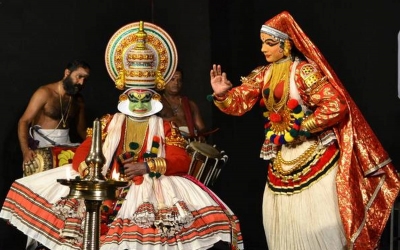
Kathakali is a major form of classical Indian dance. It is a “story play” genre of art, but one distinguished by the elaborately colorful make-up, costumes and face masks that the traditionally male actor-dancers wear. Kathakali is a Hindu performance art in the Malayalam-speaking southwestern region of India (Kerala).
The traditional themes of the Kathakal? are folk mythologies, religious legends and spiritual ideas from the Hindu epics and the Puranas. The vocal performance has traditionally been performed in Sanskritised Malayalam. In modern compositions, Indian Kathakali troupes have included women artists, as well as adapted Western stories and plays such as those by Shakespeare.
‘Kathakali’ incorporates the most intricate make-up code, costume, face masks, head dress and brightly painted faces among all Indian classical dance forms. Its unique costume, accessories and make-up complimented with spectacular performance, music and lightings bringing life to the characters of the great epics and legends attracts and flabbergasts both young and the old thus creating a surreal world around. The make-up code followed in ‘Kathakali’ conventionally typifies the characters of the acts categorising them as gods, goddesses, saints, animals, demons, and demonesses among others. This classification of characters according to Zarrilli reflects the three Gunas namely sattva (goodness, virtuous, harmonious, constructive), rajas (passion, egoistic, dynamic, action, aimless), and tamas (darkness, viciousness, chaotic, destructive) of the ‘Gu?a’ theory of personalities that originated in the age-old ‘Samkhya’ school of Hindu philosophy.
Picture Credit : Google




